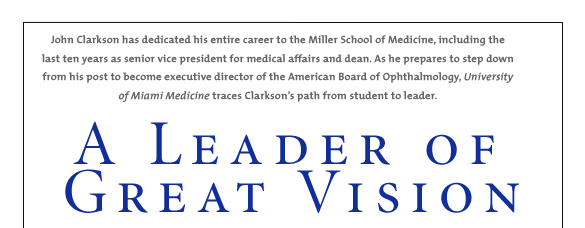 |
|
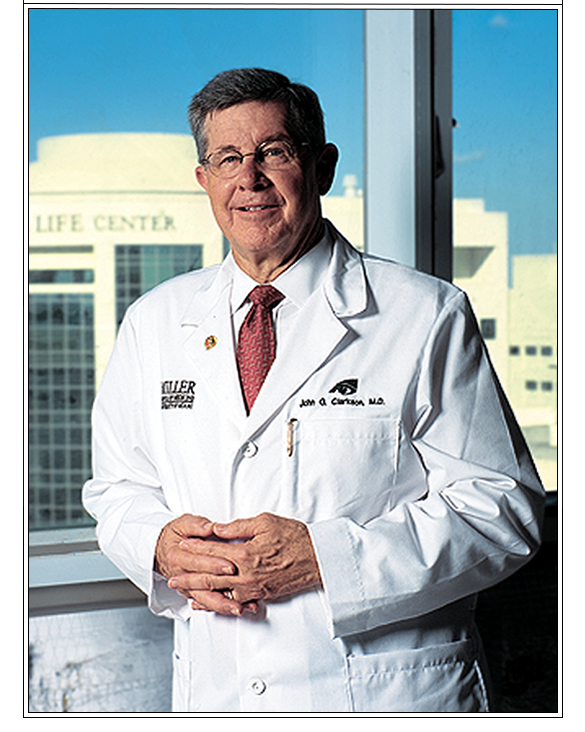 |
![]() n
the spring of 1965 two freshman medical students at the University
of Miami applied for summer positions working with
Hiram Polk Jr., M.D., a young faculty member in charge of the burn unit
in the Department of Surgery. The topic was infection in burn patients.
The surprising result was a couple of papers presented at the American
Medical Association and the Surgical Forum—and the first steps
in two long, distinguished careers in academic medicine.
n
the spring of 1965 two freshman medical students at the University
of Miami applied for summer positions working with
Hiram Polk Jr., M.D., a young faculty member in charge of the burn unit
in the Department of Surgery. The topic was infection in burn patients.
The surprising result was a couple of papers presented at the American
Medical Association and the Surgical Forum—and the first steps
in two long, distinguished careers in academic medicine.
“It was a very fortunate day when we took that car ride to Hiram’s office,” says C. Gillon Ward, M.D., professor and founder of the UM Burn Center. His partner that summer?
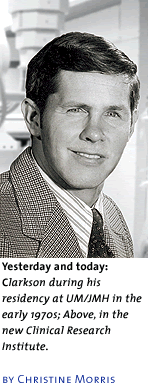 John G. Clarkson.
John G. Clarkson.
Forty years later, Clarkson and Ward are still colleagues and close friends. Though Ward watched with dismay as Clarkson strayed from general surgery to ophthalmology—“I told him the world was bigger than an eyeball”—he joins thousands of fellow faculty members, alumni, staff, patients, and community leaders who are grateful that Clarkson’s career led to the top position at the University of Miami Miller School of Medicine.
“All the qualities I saw in him as a friend are the ones that made him an excellent dean,” Ward says. “He is as honest as the day is long, his dedication to a project is unyielding, his sensitivity to people and situations is phenomenal, and his concern for others is universal.”
The result is a school that has grown tremendously in all areas of its mission. As he prepares for his new role as executive director of the American Board of Ophthalmology, Clarkson can point to an extraordinary number of successes from his decade at the helm.
He is quick to deflect the spotlight from himself to the other top-of-their-field physicians and scientists the Miller School has recruited. An ambitious plan to grow the research enterprise is being implemented. The medical curriculum has been overhauled to match the explosion of knowledge in medicine. The campus has been transformed physically, with dramatic new growth now in the works. The clinical practice is being re-engineered to provide a seamless system of care for patients. Growing numbers of patients from Miami-Dade County and beyond rely on the school’s world-class mission with Jackson Memorial Hospital.
“Life is a series of opportunities, of open doors and closed doors,” Clarkson says. “This has been a tremendous opportunity.”
The seeds of an academic career were born during the summers with Polk, but the idea of ophthalmology was planted much earlier, when the dean was in high school and began dating his future wife, Diana Teasdale. Her father, L. R. Teasdale, M.D., practiced ophthalmology in West Palm Beach. “Diana has two sisters, and I was the first somewhat permanent male around the household,” the dean recalls. “Her father was always talking to me about medicine.”
![]() couple
of conferences at Bascom Palmer Eye Institute with his father-in-law,
a visit with Edward
W. D. Norton, M.D., chairman of the institute, and a summer working with
Donald Gass, M.D., a retina specialist, followed. But based on his experience
with Polk, Clarkson entered a general surgery fellowship at Boston University.
A few months into the experience, he decided he was not going to become
a general surgeon but instead would pursue ophthalmology.
couple
of conferences at Bascom Palmer Eye Institute with his father-in-law,
a visit with Edward
W. D. Norton, M.D., chairman of the institute, and a summer working with
Donald Gass, M.D., a retina specialist, followed. But based on his experience
with Polk, Clarkson entered a general surgery fellowship at Boston University.
A few months into the experience, he decided he was not going to become
a general surgeon but instead would pursue ophthalmology.
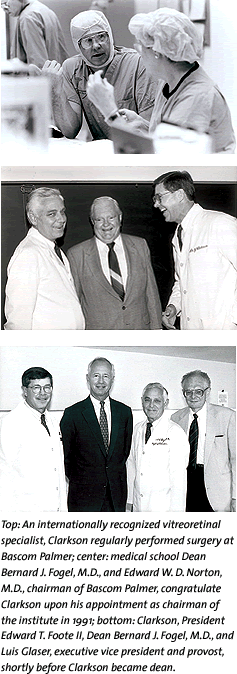 |
The Vietnam War intervened, and it turned out that the Army needed ophthalmologists—even partially trained ones. Clarkson was assigned to the ophthalmology service at Fitzsimmons Hospital in Denver and then to Fort Bragg in North Carolina. “I had wonderful commanding officers at both Fitzsimmons and at Fort Bragg who took an interest in me and encouraged me,” Clarkson says.
Among the people he met at Fort Bragg was a future colleague, William W. Culbertson, M.D., professor of ophthalmology. “I had just begun my ophthalmology residency and was there for Army Reserve summer training,” Culbertson remembers. “John was a general medical officer who had already become well known around the base hospital for learning ophthalmology there through on-the-job training well before he was to start his formal residency the next year at Bascom Palmer. This precocious start of his career was a prelude to his many future accomplishments.”
The second year of his residency at Bascom Palmer, Clarkson was chosen chief resident. That presented the opportunity to spend a year at Johns Hopkins University studying retinal vitreous surgery and ophthalmic pathology. When he came back as chief resident, the new eye hospital was opening, and he helped determine the number of beds that would be needed.
After looking at some private practice opportunities, Clarkson was offered a job at Bascom Palmer by Norton. “The department was much smaller then, but it was a group of the finest ophthalmologists in the world,” Clarkson says. “Diana and I talked about this, and I said, ‘I don’t know whether this is going to work, but it’s a great opportunity, so let’s try it for three or four years.’”
![]() ne
promotion followed another, and Clarkson was named chairman of the department
in 1991. “There was no grand design
here at all,” he
says. “Dr. Norton, Dr. Gass, Dr. (Victor) Curtin all took an interest
in me and encouraged me. I happened to be in the right place at the right
time, and I ended up with the best job in ophthalmology in the world.”
ne
promotion followed another, and Clarkson was named chairman of the department
in 1991. “There was no grand design
here at all,” he
says. “Dr. Norton, Dr. Gass, Dr. (Victor) Curtin all took an interest
in me and encouraged me. I happened to be in the right place at the right
time, and I ended up with the best job in ophthalmology in the world.”
In contrast, the dean’s position “came up at really the wrong time,” Clarkson says. “I’d only been chairman of ophthalmology for four years, and I think it takes two or three years to understand a job like that and settle in.” So the first two times he was approached about the possibility of becoming dean, he said no.
By the third time he was asked, Clarkson had been thinking hard about the opportunity to advance school-wide excellence. “I said, ‘Bascom Palmer is an important element in our medical school, but the Department of Ophthalmology can’t grow in isolation. If I can somehow serve in a capacity that elevates other aspects of the school, I can help make the whole school better.’”
“John did not choose to become dean,” says Alan Livingstone, M.D., chair of the DeWitt Daughtry Family Department of Surgery. “The job chose him.”
“He was the right person for the job because he brought stable, principled leadership at a time of turmoil,” says Laurence Gardner, M.D., vice dean and chairman of the Department of Medicine. “Now we see his influence all around us: new buildings, the endowment made possible by the Miller gift, a more modern, energized curriculum, and a commitment to build an extraordinary research enterprise.”
Clarkson is loathe to take credit for anything (one of his favorite sayings: “It’s amazing what you can accomplish if you don’t worry about who gets the credit”), and he says it’s too soon to assess the long-term impact of his decade as dean. But asking him to talk about the practice of medicine and how it should evolve prompts a detailed, far-reaching, visionary description of the path we must follow.
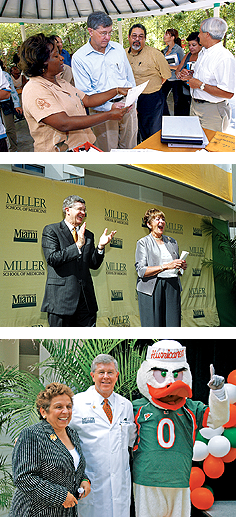 |
||
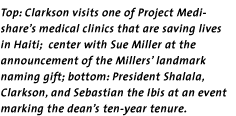 |
“One of the most confounding issues facing patients is to understand the overview of their problem,” the dean says. “They hear from the cardiologist, they hear from the internist, they hear from the surgeons, they hear from the gynecologist or urologist or whomever—but there’s no one providing an overarching picture and a short-and long-term game plan.”
And no physician is aware of exactly what the other physicians are doing. “The consequences range from inconvenience to possibly critical or even fatal errors,” Clarkson says. Reducing the rate of those errors must be medicine’s top priority.
A connected electronic system of health care information would ensure that all health care providers have access to each patient’s full, accurate picture, improving access and the quality of care. At last fall’s Ralph H. and Ruth F. Gross Lecture sponsored by the Louis Calder Memorial Library, Clarkson said another key to improving quality of care is dramatically increasing the use of simulation—for our medical students, for the physicians in our training programs, and for the practicing physicians in our community.
Improved communication among all team members involved in the delivery of care is critical as well, Clarkson told his audience. He proposes a closer look at prospective medical students’ interpersonal skills, demonstration of teamwork, and broader life experience, and he challenges medical educators to come up with an instrument or technique for evaluating these critical factors.
Once those medical students are practicing physicians, continued evaluation is more challenging—but never more important, Clarkson said. In his leadership role at the American Board of Ophthalmology, a certifying agency of the American Board of Medical Specialists, Clarkson will ensure that ophthalmologists maintain top professional skills. “I see this role as a broader one where I can participate with the rest of medicine to make sure that ophthalmologists can prove their ability to provide the most advanced care for patients,” Clarkson says.
Between that and a new role at the Miller School, Clarkson will not slow down. He may have a bit more time for enjoying his three grandchildren, and he will no doubt continue rooting for Miami football teams and playing golf. Ward describes him as a “very intense” golfer, adding, “Unfortunately, the mental results of his game do not match what happens on the course.”
Gardner, another close friend, lured the Clarksons to Europe a couple of years ago. “We have a terrific time traveling with them,” Gardner says. “The dean has a great sense of humor when he’s not under the pressure that he’s under most of the time here.”
![]() veryone who knows Clarkson talks about his honesty,
his strong character, his exacting standards. The person with the most
intimate knowledge of
the medical school’s top job, Dean Emeritus Bernard J. Fogel, M.D.,
says about his successor: “In 1964 I attended the School of Medicine’s
graduating class dinner. The president of the Class of 1968 was John
Clarkson. His leadership abilities were quite apparent, and I teased
that someday
he would be a medical school dean.
veryone who knows Clarkson talks about his honesty,
his strong character, his exacting standards. The person with the most
intimate knowledge of
the medical school’s top job, Dean Emeritus Bernard J. Fogel, M.D.,
says about his successor: “In 1964 I attended the School of Medicine’s
graduating class dinner. The president of the Class of 1968 was John
Clarkson. His leadership abilities were quite apparent, and I teased
that someday
he would be a medical school dean.
“Over the past 26 years he and I have served as deans of a great institution. His honesty, good judgment, dedication, fairness, and passion for doing the right thing made my earlier prophesy correct. We have been extremely fortunate that his entire academic career has benefited this school.”
At the end of November Clarkson held a party for all medical faculty, staff, and students. President Donna E. Shalala sang the dean’s praises, Sebastian the Ibis led cheers, and Clarkson, characteristically, talked about everybody but himself. “Today isn’t about me,” he told the crowd. “It’s about you, to thank you for what you do every day to make this medical school a better place.
“The best is yet to come, and it’s because of you.”